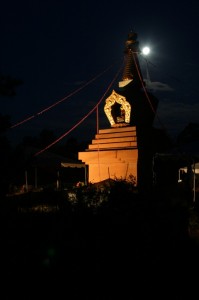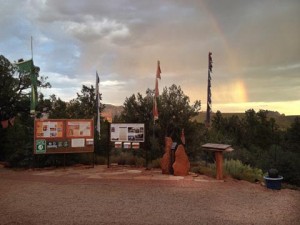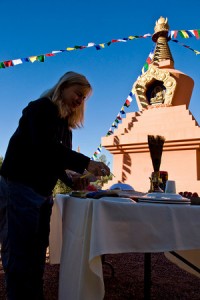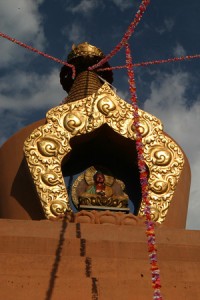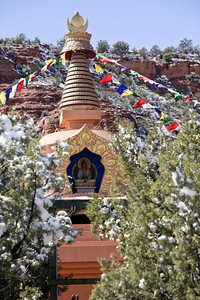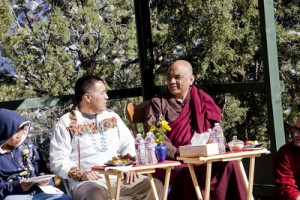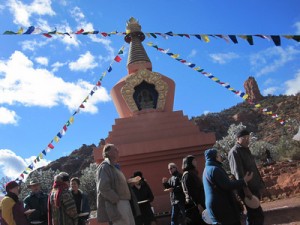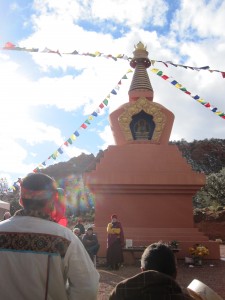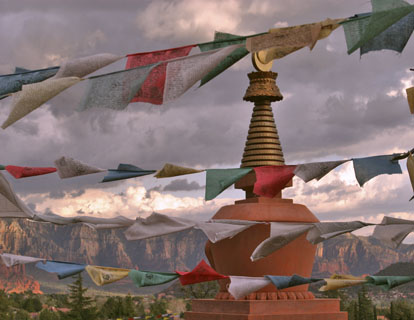
Amitabha Stupa in Sedona
An excerpt from the teaching, “Cosmology of a Stupa” given by Tulku Sang-ngag Rinpoche on the occasion of the consecration of the Amitabha Stupa in Sedona, Arizona
This tradition of building stupas was passed down in India and finally reached Tibet. It was brought to Tibet by the very first Buddhist master to arrive there, Shantarakshita. He was a very great abbot who was the first to teach the Dharma in Tibet. At that time, all of the rituals and all the ceremonies related to building a stupa were translated and established by Shantarakshita. This was prior to the arrival of Guru Rinpoche.
Shakyamuni Buddha taught King Tsaldyor about the incredible benefits that one could derive from both erecting a stupa. There is also a discussion by the Buddha on the benefits of circumambulating a stupa, going around a stupa in order to accumulate merit.
It is said that when building a stupa, if you simply offer a handful of sand and place it in the mortar, that handful of sand is equivalent to offering many thousands of ounces of gold to the enlightened ones. It is equivalent in merit. If you labor at making a stupa, whether for work or play even if you are just sitting there drawing a rendition of the stupa, you make a connection with it. There is contact made and by virtue of having contact, you are connecting with enlightenment, so you receive a blessing. You accumulate merit.
There is a story that illustrates this. In one of the Buddha’s previous lifetimes there were these seven bugs that lived on a leaf of a tree that was beside a lake. And in the middle of that lake there was a stupa. One day, that leaf just broke off the tree, floated down to the water and then was blown around the stupa a few times, and then finally the bugs drowned. But because they went around the stupa a few times, they received a blessing. Traditionally it is said that the seed of liberation was planted in their mind stream. And because there was that seed present, it had to ripen and eventually after a few lifetimes, all those bugs awakened to enlightenment by virtue of the fact that they accumulated that merit.
By seeing a stupa or hearing about a stupa, remembering it, visualizing it, whatever the case may be, any kind of connection will imbue you with a blessing, will connect you to enlightenment. Whether a bug, a human, or an animal without a body just floating through space, any being that comes in contact with a stupa will be blessed and gain merit.
A stupa can be considered an outward symbol that the Buddha’s teachings endure. The stupa is a representation of the Buddha. Even now, the original Buddha’s stupa is still there in Bodh Gaya in Behart, north central India. And it is an object of homage for countless people. Every year, hundreds of thousands, possibly millions of pilgrims visit there to pay respects and to offer prostrations. A stupa, as a symbol that represents the Buddha, is treated as such. Numerous monks and nuns go there to receive ordination, blessings and so on. There are people from Thailand and Hong Kong and Japan, and from all over the world who go there to see that stupa and receive the blessings.
In the past, there have been many stories of relics appearing from these stupas. As mentioned earlier, there is that phenomenon known as ringsel, the small relic pills, which would spontaneously be emitted from the stupa. Sometimes it even rained from the sky in the vicinity of the stupas, such as the stupas in Boudnath and Svayambhu. There are numerous stories. But these days it is not happening as frequently as it used to in the past. This might be because of the change in the times. Due to corruption or degeneration, it is not as frequent as it used to be.
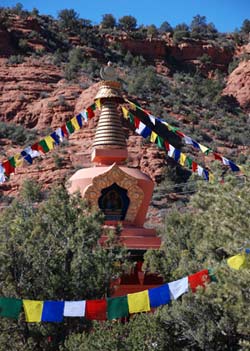
I really enjoy working with stupas, creating them, helping in their construction. So far, in the States, I have helped with 13 stupas, and all together more than 20 stupas. The reason why is because stupas are really such great phenomena. If you are building a temple or something like that, then it is kind of a mixed bag. There is administration. You have to manage things. It is a great thing to do, but it can be complicated, because you are involved with people and all sorts of things can happen. Whereas with a stupa, right from the word go, everything is very virtuous. It is simple. A stupa is expressly made for virtue, so that people can pay homage, so that they can accumulate merit and receive a blessing.
It is a very simple and very straightforward matter. Right from the onset, it is all about virtue. In the interim it is about virtue and at the end, it’s all about virtue. With other things, you have to manage the money, the people, and the upkeep. With a temple you never know where it is going, but with a stupa, it is straightforward and clear cut.
In their final testaments to the people of Tibet, Guru Rinpoche and Shantarakshita said that the problems of cyclic existence could be remedied through the medium of a stupa, because there are so many different types of stupas that address different problems. For example, when things really degenerate, and we find ourselves now at the time known as the five types of degeneracy. For times of conflict, there is a type of stupa that works as a counteragent to conflict by creating harmony. There are stupas that remedy diseases, plagues, famines, and poverty.
There are a wide variety of stupas to address all the different problems that we have in this world. For example, if a country is suffering from intense poverty, then you would erect a Dzambala palace stupa, which is similar to the palace of Dzambala itself; and because of the law of interdependence, we have created the auspicious interdependent coincidence for poverty to be alleviated and to create wealth. This is how these stupas actually function – through the law of interdependence.
There are all kinds of stupas that work with different situations. There is the stupa that represents the enlightened body, speech and mind. For beings who wish to achieve complete awakening, who aim for realization of absolute truth and liberation, then one of those types of stupas would be created and homage paid to it.
It is in light of the fact that there are so many virtues, so many great qualities connected with the stupas that when I heard that the sangha here had made so many stupas before and wished to make some more, that I was completely overjoyed. I really rejoice in this kind of activity. It is my favorite thing to do. It is the thing I feel the most enthusiasm towards. Out of all the different things that I can do, I love creating stupas and helping with their construction.
Actually, last year, I thought that I would change the way I do things and concentrate on my work in Montana, and not go around too much. But when I heard that there was a stupa to be made, I couldn’t help myself. I feel that whenever it is related to a stupa, I am always available. I want to commit myself to helping develop this stupa. I feel very strongly about it. I am full of enthusiasm. I have made this commitment now.
All of you who are engaged in the work of erecting the stupa, please remain in your commitment to that. Don’t deviate from your commitment. And also, all of your work should be imbued with love and compassion for all beings. It should be motivated by that precious bodhicitta. That is really of primary importance. Then the merit and wisdom will be beyond measure.
Whether you are working to build the stupa or made an offering or whether you simply rejoice in such good activity and the presence of a stupa like that, if you are motivated by compassion and love, and if compassion completely infuses your whole being and you make aspiration prayers that all beings benefit by the presence of having a stupa there, then the merit and the blessing can’t be measured. That is very important. Our lives are very short. We could pass away at any time. But the stupa is something that really endures. So, it is incredibly meaningful to relate to the stupa. It is something that remains present in this world. It could be hundreds of years, thousands of years; it could be a very long time. All during that time, beings are receiving blessings, and merit is accumulated. One’s aspiration prayers are constantly being fulfilled. It is enduring, ongoing phenomena. The effect of it is immense and the implications are incredible.
If you want to multiply your virtue endlessly, connect with a stupa. I am completely rejoicing and thank everybody who is involved with that.
